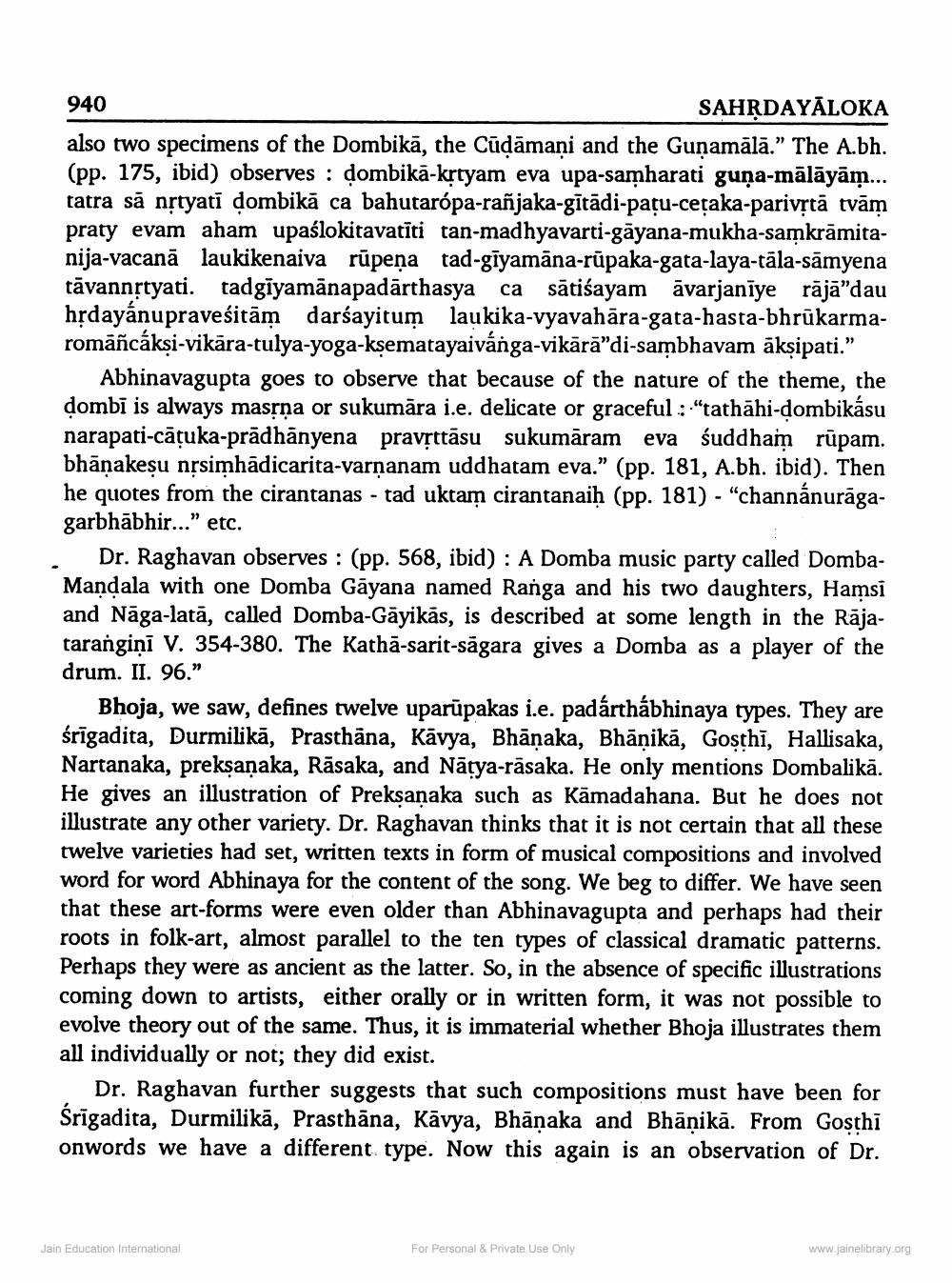________________
940
SAHRDAYĀLOKA also two specimens of the Dombikā, the Cūdāmaņi and the Guņamālā.” The A.bh. (pp. 175, ibid) observes : dombikā-krtyam eva upa-samharati guņa-mālāyām... tatra să nộtyati dombikā ca bahutarópa-rañjaka-gītādi-pațu-cețaka-parivstā tvām praty evam aham upaślokitavatīti tan-madhyavarti-gāyana-mukha-samkrāmitanija-vacanā laukikenaiva rūpeṇa tad-giyamāna-rūpaka-gata-laya-tāla-sāmyena tāvannstyati. tadgiyamānapadārthasya ca sātiśayam avarjaniye rājā”dau hțdayánupraveśitām darśayitum laukika-vyavahāra-gata-hasta-bhrūkarmaromāñcákși-vikāra-tulya-yoga-ksematayaivánga-vikārā”di-sambhavam ākṣipati.”
Abhinavagupta goes to observe that because of the nature of the theme, the dombi is always masrna or sukumāra i.e. delicate or graceful :-"tathāhi-dombikāsu narapati-cāțuka-prādhānyena pravsttāsu sukumāram eva śuddham rūpam. bhāņakeșu nșsimhādicarita-varṇanam uddhatam eva.” (pp. 181, A.bh. ibid). Then he quotes from the cirantanas - tad uktam cirantanaih (pp. 181) - "channánurāgagarbhābhir...” etc.
Dr. Raghavan observes : (pp. 568, ibid): A Domba music party called DombaMandala with one Domba Gāyana named Ranga and his two daughters, Hamsi and Nāga-latā, called Domba-Gāyikās, is described at some length in the Rājatarangiņi V. 354-380. The Kathā-sarit-sagara gives a Domba as a player of the drum. II. 96."
Bhoja, we saw, defines twelve uparūpakas i.e. padárthábhinaya types. They are śrīgadita, Durmilikā, Prasthāna, Kāvya, Bhāņaka, Bhānikā, Gosthi, Hallisaka, Nartanaka, preksanaka, Rāsaka, and Nātya-rāsaka. He only mentions Dombalikā. He gives an illustration of Preksanaka such as Kāmadahana. But he does not illustrate any other variety. Dr. Raghavan thinks that it is not certain that all these twelve varieties had set, written texts in form of musical compositions and involved word for word Abhinaya for the content of the song. We beg to differ. We have seen that these art-forms were even older than Abhinavagupta and perhaps had their roots in folk-art, almost parallel to the ten types of classical dramatic patterns. Perhaps they were as ancient as the latter. So, in the absence of specific illustrations
down to artists, either orally or in written form, it was not possible to evolve theory out of the same. Thus, it is immaterial whether Bhoja illustrates them all individually or not; they did exist.
Dr. Raghavan further suggests that such compositions must have been for Srigadita, Durmilikā, Prasthāna, Kavya, Bhānaka and Bhānikā. From Gosthi onwords we have a different type. Now this again is an observation of Dr.
Jain Education International
For Personal & Private Use Only
www.jainelibrary.org




